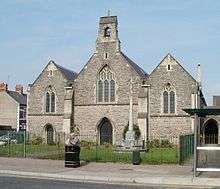St Saviour's Church, Splott
| St Saviour's Splott | |
|---|---|
 | |
| 51°29′02″N 3°09′05″W / 51.4838°N 3.1514°WCoordinates: 51°29′02″N 3°09′05″W / 51.4838°N 3.1514°W | |
| Denomination | Church in Wales |
| History | |
| Status | Active |
| Founded | 1884 |
| Consecrated | 30 October 1888 |
| Architecture | |
| Functional status | Parish Church |
| Heritage designation | Grade II |
| Designated | 12 February 1952 |
| Architect(s) | G. F. Bodley |
| Groundbreaking | 28 January 1892 |
| Specifications | |
| Materials | Swelton stone, Bath stone |
| Bells | 1 |
| Administration | |
| Parish | Roath St Saviour |
| Deanery | Cardiff |
| Archdeaconry | Llandaff |
| Diocese | Diocese of Llandaff |
St Saviour's Church is a Church in Wales church in Splott, Cardiff, South Wales.[1]
Early history
In the late 19th Century, a large number of churches were built in Cardiff as the city expanded, and what had been villages were absorbed into the growing city. Splott, then called East Moors or Old Moors, had several new churches built. A school chapel, dedicated to St Columba had been founded in 1877. St Saviour's was established as a tin tabernacle in 1884. Both of these buildings were replaced with the present church in 1888. Its appearance was modelled on St Mary's Church, Tenby,[2] though lacks its spire. Originally a daughter church of St German's, St Saviour's saw the creation of its own parish on 30 January 1893.[3] The south aisle was added in 1894. Like many Cardiff churches, St Saviour's has a war memorial.
The church became Grade II listed in 1952.[4]
Recent history
Many churches in Cardiff closed in the postwar years, though St Saviour's managed to avoid this fate. In 1961, it saw a restoration by George Pace which saw the subdivision of the nave into a hall. Despite this, its Victorian image remains largely unaltered (though some of the stained glass dates only from the 1960s).[5] In 1985, the old church hall on the opposite side of the street was sold off. It was replaced with the present structure (as well as a new vestibule), which was opened on 15 May 1987.[6]
In 2011, the lead was stripped from the roof of the church's porch, but was abandoned nearby.[7]
References
- ↑ "Church in Wales". Retrieved 17 April 2017.
- ↑ Rose, J. Cardiff Churches through Time. Amberley. 2013.p.23
- ↑ Childs, J. Roath, Splott and Adamsdown. History Press. 1995. p.68
- ↑ "British Listed Buildings". Retrieved 17 April 2017.
- ↑ "Coflein". Retrieved 17 April 2017.
- ↑ "church website". Retrieved 17 April 2017.
- ↑ "The Guardian". Retrieved 17 April 2017.